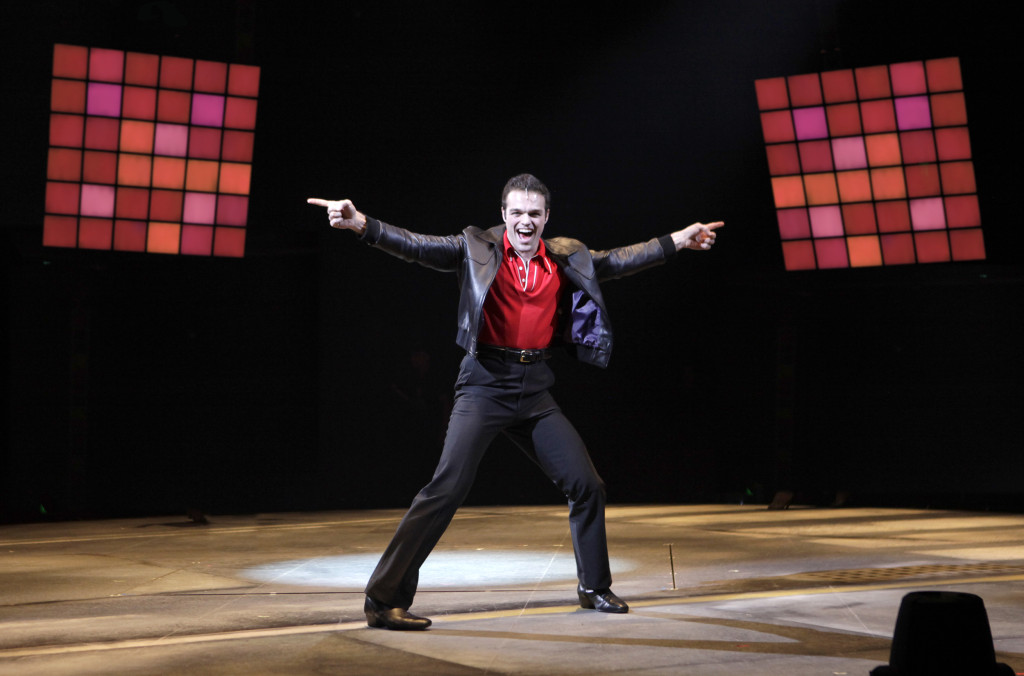
Sam Wolf as Tony Manero in SATURDAY NIGHT FEVER The Musical playing at North Shore Music Theatre August 11 – 23, 2015. Photo © Paul Lyden
Presented by North Shore Music Theatre
Original Stage Adaptation by Robert Stigwood & Bill Oakes
North American Adaptation by Sean Cercone & David Abbinanti
Directed by Richard Stafford
Choreographed by Nick Kenkel
Music direction by Milton Granger
Assistant music direction by Joseph Mohan
August 11th – 23rd, 2015
62 Dunham Road
Beverly, MA 01915
NSMT on Facebook
Review by Craig Idlebrook
An old Rolling Stone profile of the Bee Gees, the band behind the music for Saturday Night Fever, included a heartbreaking moment – the band was on top of the world at the time, but one of the Gibb brothers spent the entire interview nervously scrolling the radio dial to hear if any station was playing his music.
This moment so encapsulates the desperate bravado of Tony Manero, the central character in Saturday Night Fever, the movie that has now been converted into a surprisingly well-made musical. While we may come for the spectacle of a bygone era of disco, at the heart of this story is the tale of a young man who sees no way out of his neighborhood. It is the late seventies, and America is stuck in a recession, its greatness questioned for the first time in generations. Manero is stuck in a rundown neighborhood in New York City, back when the city was a crime-ridden cesspool prone to blackouts. Even worse, the old definitions of masculinity are crumbling, as his father has lost his job and seems rudderless. He finds solace in creating an identity of hyper-masculinity on the dance floor, with an open shirt, a jutting-out chin, and a willingness to treat women as interchangeable objects of his pleasure.
The North Shore Music Theatre’s production of this musical does an exquisite job bringing out the emotional core of this story, while also providing crisp, crowd-pleasing dance numbers to keep the action moving, a seemingly impossible task. It’s rare to lead in a review with the lighting, but special credit to this production’s success must go to lighting designer Kirk Bookman, as the play, when not under a disco ball, is perfectly cast in a subtle yellowish pall (one can almost taste the particle emissions of the city at a time before catalytic converters). Bookman’s lighting provides a jaundiced shadow, creating a sense of foreboding on what on the surface seems like plucky, youthful exploits.
Director Richard Strafford builds on this twilight world, allowing space for the awkward snatches of conversation among these emotionally stunted young men and women to have meaning. Each snippet of conversation appears to say so little, except for the uncertainty created in the silences. Those emotional beats make the dance numbers all the more bombastic, and choreographer Nick Kenkel drives those numbers home with some great and unabashedly disco-y dance sequences.
It leaves it up to Sam Wolf to own the stage as the lead, Tony Manero. There is a moment of fright when Wolf first appears and doesn’t completely own the stage in Travoltaesque fashion, but we are soon drawn into the character as we realize he is someone who has been told to bathe in the spotlight of masculinity, whether he likes it or not. Wolf’s Manero leads with his chin, and seems always aware he is one step away on the dance floor from falling down. Wolf is ably supported by a deep cast of rich characters, all of whom infuse the play with their own uncertainties.
I never thought I would say this, but this play, highlighting the disco era, is simply timeless.
